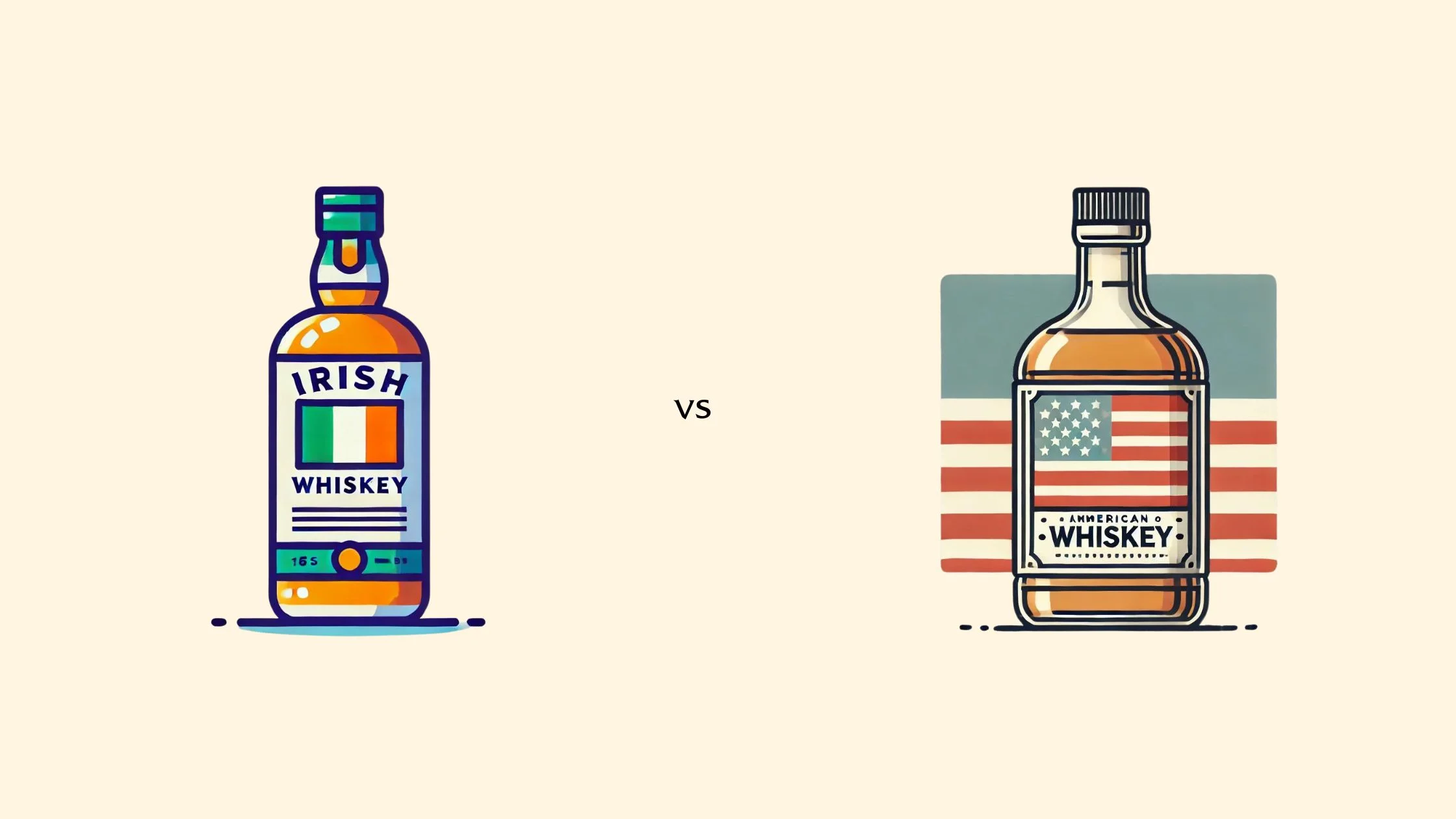When diving into the world of whiskey, the debate between American and Irish varieties often sparks lively conversations. Both types boast rich histories and unique characteristics that make them beloved by enthusiasts worldwide. American whiskey, with its bold and diverse flavor profiles, is often crafted using corn, rye, and barley, and aged in charred oak barrels for a minimum of two years. This process imparts notes of vanilla, caramel, and smokiness, creating a robust tasting experience.
On the other hand, Irish whiskey is known for its smooth, light character, thanks to its triple distillation process and use of malted barley. Aged for at least three years in wooden barrels, it often features subtle flavors of honey and fruit, making it an easy sipper.
This article will explore the origins, production methods, and tasting notes of both American and Irish whiskeys, helping you understand their distinctive qualities and find your personal favorite
The Defining Characteristics of American Whiskey
American whiskey is distinguished by its strict production standards and distinctive flavor profiles, primarily derived from corn. It is mandated to be distilled to no more than 80% alcohol by volume and aged in new, charred oak barrels, a key factor in its rich, full-bodied taste. The aging process is a critical component, with types like Bourbon and Tennessee whiskey requiring a minimum of two years in barrels.
However, many expressions are aged longer to achieve a more complex flavor profile. This maturation process, enhanced by the unique climatic conditions of the United States, accelerates the whiskey’s development, imbuing it with a complexity and variety that are uniquely American. The result is a spirit that not only embodies the essence of its raw materials but also the meticulous craftsmanship of its distillers.
Notable American whiskey brands and their flagship products include Buffalo Trace Distillery with its eponymous Buffalo Trace Bourbon, Jack Daniel’s renowned for its Old No. 7 Tennessee Whiskey, and Wild Turkey offering its classic 101 Bourbon. These brands exemplify the innovation and tradition of American whiskey, with distilleries like Maker’s Mark and Woodford Reserve pushing the boundaries through experimental aging processes and unique grain selections.
American whiskey, therefore, offers connoisseurs a genuine taste of American heritage and innovation, making it a revered category within the global spirits landscape.
The Defining Characteristics of Irish Whiskey
Irish whiskey is renowned for its smoothness and approachability, a result of its triple distillation process and the inclusion of unmalted barley in many of its styles. This meticulous distillation not only purifies the spirit but also endows it with a lighter, more refined taste. Aged for at least three years in wooden casks, it develops a nuanced complexity, often revealing notes of fruit, spice, and a delicate sweetness.
Iconic Irish whiskey brands such as Jameson, known for its rich, smooth taste and versatility in cocktails, and Redbreast, offering a range of aged single pot still whiskeys with complex flavors, exemplify the quality and diversity within the category. Bushmills, with its signature malt whiskeys, highlights the influence of the unique Northern Irish climate and traditional distilling methods. The category of Irish whiskey encompasses a range of styles, including single malts, blends, and single pot still whiskeys, each offering a distinct flavor profile while maintaining the hallmark smoothness.
Regions like Cork, with its maritime climate, contribute to the mellow character of whiskeys like Midleton Very Rare, while the rugged landscape of Connemara is reflected in the peated malt of Connemara Peated Single Malt. This diversity, rooted in tradition, highlights the richness of Irish whiskey, making it a cherished spirit across the globe. It invites connoisseurs and casual drinkers alike to explore Ireland’s deep distilling traditions, presenting a spirit that is both versatile and uniquely Irish.
In What Ways Are They Similar?
Despite the unique characteristics that define American and Irish whiskeys, they converge on a shared foundation of quality and tradition. Both whiskey types undergo rigorous distillation processes and adhere to strict aging protocols, ensuring the creation of a premium spirit. A key similarity is their aging in wooden barrels, a technique that infuses each whiskey with distinctive flavors and complexity.
Moreover, both traditions honor the grain as the heart of their spirits—corn in American whiskey and barley in Irish whiskey—highlighting their agricultural heritage. This common ground underscores a mutual respect for the art of whiskey making, connecting American and Irish whiskeys in their quest for excellence and depth of flavor. Brands like Jack Daniel’s and Jameson, for instance, exemplify their respective whiskey categories’ commitment to quality, each with a storied history and a broad appeal that transcends borders.
Additionally, both industries face similar challenges, such as sustainability and environmental impact, leading to innovative practices like water recycling and energy efficiency in distilleries like Maker’s Mark in the US and Midleton in Ireland. These efforts showcase a shared commitment to preserving their rich heritage while embracing modernity.
In What Ways Are They Different?
The paths of American and Irish whiskeys diverge notably in their production methods, base ingredients, and flavor profiles. American whiskey’s primary grain is corn, lending a sweeter and bolder taste, and it must age in new, charred oak barrels, adding a unique richness and depth. Conversely, Irish whiskey frequently employs a blend of malted and unmalted barley and undergoes triple distillation, achieving a smoother and lighter spirit.
For example, a typical Bourbon might offer tasting notes of deep vanilla, caramel, and a hint of smoke, reflective of its corn dominance and new oak aging. In contrast, a classic Irish whiskey could present lighter, floral notes with a smooth finish, a testament to its triple-distilled barley composition. The aging process further distinguishes them; American whiskey benefits from the character of new wood, while Irish whiskey often matures in previously used barrels, introducing a different spectrum of flavors.
The climate in each country also plays a crucial role in the aging process. The varying temperatures and humidity levels in the United States, especially in regions like Kentucky, accelerate the aging process, intensifying the whiskey’s flavors. In Ireland, the relatively stable and mild climate contributes to a slower, more gradual maturation, allowing for the development of its characteristically smooth and subtle flavors.
Comparing American Whiskey and Irish Whiskey
When delving into the comparison between American whiskey and Irish whiskey, key facets such as flavor, price range, distillation process, popularity, and critical acclaim come to the forefront. American whiskey is characterized by its sweeter, more robust flavor profile, thanks to its corn base and aging in new oak barrels. In contrast, Irish whiskey is known for its smoother, lighter taste, a result of its triple distillation and barley usage.
The price range for each can vary significantly, influenced by aging time and production intricacies. The distillation process—double for American and triple for Irish—plays a crucial role in defining each spirit’s unique character. In terms of popularity and critical acclaim, both American and Irish whiskeys enjoy global recognition, each boasting a dedicated following and numerous awards.
These comparative insights not only highlight the distinctive attributes of American and Irish whiskeys but also celebrate the rich diversity within the whiskey realm, accommodating a wide spectrum of tastes and preferences.
Comparing Their Flavor
| American Whiskey | Irish Whiskey |
|---|---|
| Sweeter, more robust flavor with notes of vanilla, caramel, and oak. | Smoother, lighter taste with hints of fruit, spice, and a gentle sweetness. |
Comparing Their Price Range
| Type | Entry-Level | Mid-Range | Premium |
|---|---|---|---|
| American Whiskey | $20-$35 | $36-$60 | $61+ |
| Irish Whiskey | $25-$40 | $41-$65 | $66+ |
Comparing Their Distillation Process
| Distillation Process | American Whiskey | Irish Whiskey |
|---|---|---|
| Number of Distillations | Typically twice | Triple distillation |
| Barrel Type | New, charred oak barrels | Mix of new and previously used barrels |
Comparing Their Popularity
| Year | American Whiskey Sales (Millions) | Irish Whiskey Sales (Millions) |
|---|---|---|
| 2021 | 24.5 | 12.3 |
| 2022 | 26.2 | 14.1 |
Comparing Their Critical Acclaim
| Award/Competition | American Whiskey | Irish Whiskey |
|---|---|---|
| World Whiskies Awards 2022 | Multiple Golds in Various Categories | Multiple Golds in Various Categories |
| International Spirits Challenge 2022 | Several Trophies and Gold Medals | Several Trophies and Gold Medals |
Who Is American Whiskey Best For?
American whiskey is the perfect choice for those who savor a bold, rich flavor profile, marked by distinctive notes of vanilla, caramel, and oak. It appeals to enthusiasts keen on delving into the intricacies of grains, aging processes, and the artisanal craft behind each distillation. Whether one’s preference lies in the sweet smoothness of Bourbon, the spicy undertones of Rye, or the gentle mellow of Tennessee whiskey, the American whiskey spectrum caters to a broad array of tastes.
For beginners, a smooth and accessible Bourbon like Buffalo Trace offers a perfect entry point into the world of American whiskey, with its balanced sweetness and complexity. Enthusiasts might gravitate towards Four Roses Single Barrel, which showcases the nuanced character that American whiskey can offer, with its rich flavors and depth. Collectors will find exceptional value in seeking out limited releases like Pappy Van Winkle’s Family Reserve, known for its rarity and exceptional quality, embodying the pinnacle of American whiskey craftsmanship.
It’s also a prime pick for cocktail aficionados, as its robust flavors shine through in mixed drinks, offering depth and complexity. For collectors, the realm of American whiskey presents a treasure trove of limited editions and craft expressions, promising rich opportunities for exploration and investment.
Who Is Irish Whiskey Best For?
Irish whiskey is the ideal choice for those who cherish a smooth, approachable spirit characterized by its delicate complexity and lightness. Its triple-distillation process and the balanced use of malted and unmalted barley create a cleaner, more refined taste, making it highly accessible for newcomers and a delightful change of pace for connoisseurs. Brands like Jameson are known for their approachability, while Redbreast offers a premium single pot still experience, appealing to those seeking depth and richness.
Green Spot provides a lighter, fruitier option, showcasing the versatility within the category. This whiskey’s versatility is a boon for cocktail enthusiasts, as its gentle character blends seamlessly with a variety of mixers, enhancing drinks without overpowering them. For those new to the whiskey world, brands like Bushmills offer an accessible entry point with their smooth and mellow blends, perfect for sipping neat or mixing in cocktails.
For collectors and those with a keen interest in the heritage of whiskey, the expanding selection of premium and aged Irish whiskeys offers a fascinating exploration of nuanced flavors and rare, distinguished bottles. Limited editions from Midleton Very Rare to older expressions of Teeling showcase the rich tradition and innovative spirit of Ireland’s distilleries, providing collectors with both a taste of history and a glimpse into the future of whiskey making in Ireland.





